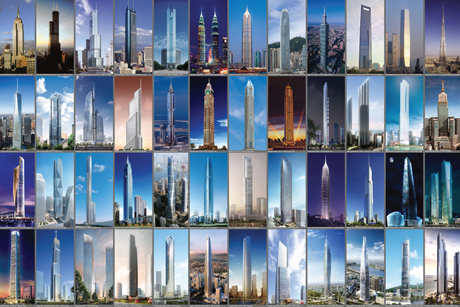The Skyscraper Museum is devoted to the study of high-rise building, past, present, and future. The Museum explores tall buildings as objects of design, products of technology, sites of construction, investments in real estate, and places of work and residence. This site will look better in a browser that supports web standards, but it is accessible to any browser or Internet device.
Installation Walkthrough
SUPERTALL! is an international survey of superlative towers featuring projects that have been completed since 2001, are under construction, or are expected to top out by 2016. This recent generation of giants, generally 100 stories or higher, represents a new paradigm of slender mixed-use towers that explore innovative approaches in engineering, curtain-wall and construction technologies, energy efficiency and sustainability, and concepts of vertical communities.
To distinguish the rarified air of the super- from the merely very tall, the Museum made the benchmark 380 meters/ 1,250 feet-the height of the Empire State Building-rather than the common standard of 300 meters. Worldwide, 48 projects measure up, including six towers of 600 meters or taller, six of 500+ meters, and twenty-four exceeding 400 meters. The world's tallest building, Burj Khalifa, rises 828 meters/ 2,717 feet above the sands of Dubai. It will hold the record for at least five years- the typical time it takes to construct a supertall.

The new spheres of architectural ambition are in Asia, especially China and South Korea, as well as in the Middle East. India also promises to be a future center of high-rise aspirations. When the Twin Towers were destroyed in the terrorist attacks of 9/11, many predicted the end of the skyscraper era. They were wrong. As the exhibition shows, supertalls are a significant building type of the 21st century.
The 2007 Supertall Survey, at left, is compared, at right, with the 2011 Survey.

* * *
SUPERTALL! is presented with generous support from Turner Construction Company.

SUPERTALL! is supported, in part, by public funds from the New York City Department of Cultural Affairs in partnership with the City Council.

SUPERTALL! is supported, in part, by public funds from the New York State Council on the Arts with the support of Governor Andrew Cuomo and the New York State Legislature.

EXHIBIT CREDITS
Supertalls were invented in New York and Chicago, and to an astonishing extent still today, the architects and engineers of supertalls worldwide are based in these American cities. For much of our research, the Museum traveled by bike and subway to interview designers and their teams. To our friends at SOM, KPF, PCF, PCP, HOK, NBBJ, TT, LERA, WSPCS, and Arup, heartfelt thanks.
For their talent, intelligence, experience, and generous spirit in sharing their knowledge of skyscraper design and engineering, the Museum thanks the following firms, in alphabetical order:
Adrian Smith + Gordon Gill Architecture; Aedas Limited; Arup; Dennis Lau & Ng Chun Man Architects & Engineers, Ltd.; East China Architectural Design and Research Institute; Foster + Partners; Gensler; Goettsch Partners; Architect Hafeez Contractor; Hellmuth, Obata and Kassabaum; Kohn Pedersen Fox Associates PC, Leslie E. Robertson Associates, RLLP; Murphy/Jahn, Inc.; NBBJ; NBS Tchoban Voss; P&T Group; Pei Cobb Freed & Partners; Pelli Clarke Pelli Architects; Skidmore, Owings & Merrill LLP; Smallwood, Reynolds, Stewart, Stewart & Associates, Inc.; Thornton Tomasetti; Wilkinson Eyre Architects, and WSP Cantor Seinuk. For his extraordinary photographs of the construction at the World Trade Center site, we thank John Bartelstone.
Many other individuals gave invaluable assistance. The Museum thanks the interns and staff who conducted research; Lidia Bardhi, Shayna Cooper, Jacqueline Hall, Allison Hollinger, Ondel Hylton, Emi Noguchi, Brendan Pettersen, Kate Reutershan, and Oscar Tena; and volunteers Tatiana Hodapp and Lesley Sun, for their dedicated research on Chinese cities, Gideon Sorkin, for his dedicated structural engineering research, and Bonny Nichol. Thanks to Emerson Argueta, Ondel Hylton, and Joanna Shin for their graphic and installation work. Additional thanks to Matthew Pinto of Social-Ink.
